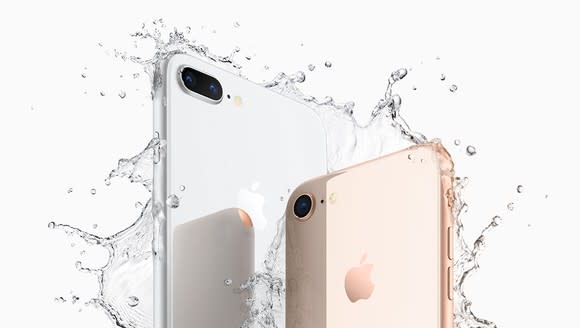This Popular Apple Inc. Product May Be Discontinued in 2018
In the fall of 2014, Apple (NASDAQ: AAPL) introduced not just one but two large-screen smartphones -- the iPhone 6 and iPhone 6 Plus. While Apple's iPhone 5s, which launched in the fall of 2013, had a modest 4-inch display, the iPhone 6 sported a 4.7-inch display and the iPhone 6 Plus came with a jumbo 5.5-inch display.
These phones sold incredibly well, helping to propel Apple's iPhone unit shipments and revenue to record levels.Â
Since then, Apple has introduced newer versions of these phones in the form of the iPhone 6s and 6s Plus, 7 and 7 Plus, and, just recently, the 8 and 8 Plus.

Image source: Apple.
The iPhone 7 Plus proved a success in the market thanks to a shift in customer preferences toward larger-screen devices, as well as the inclusion of a dual-lens camera system that was excluded from the standard iPhone 7.
During Apple's most recent earnings call , CEO Tim Cook commented on the sales velocity of the iPhone 8 Plus, which went on sale back in September, saying that it had "gotten off to the fastest start of any Plus model."
"That, for us, was a bit of a surprise," Cook added.
So it may be surprising when I predict that the iPhone 8 Plus will be discontinued when Apple introduces its new iPhones in 2018.
Here's why I think that could happen.
Make way for the 6.1-inch iPhone
Next year, Apple is set to launch an iPhone with a 6.1-inch liquid crystal display, according to KGI Securities analyst Ming-Chi Kuo. The device is expected to have minimal bezels, just as today's iPhone X does, and is also expected to feature Apple's 3D sensing TrueDepth camera to allow for features such as Face ID and Animoji.
This device is expected to serve as a lower-cost alternative to next year's iPhone X series of smartphones, which should use higher-end organic light-emitting diode displays and, according to Kuo, better design and technology specifications.
Kuo also expects such a device to start at between $649 and $749.
Let's suppose Apple introduces such a device at $699, or the midpoint of Kuo's expectations. Where would that leave this year's iPhone 8 Plus, which currently starts at $799?

Image source: Apple.
Apple typically discounts prior-generation iPhones by about $100 when a new generation rolls out, so Apple could wind up selling the baseline iPhone 8 Plus and the baseline 6.1-inch LCD iPhone for roughly the same price.
If those two devices come in at the same price, then I think consumers will overwhelmingly choose the 6.1-inch LCD iPhone, because it'll have a larger display, a more advanced front-facing camera system, and at least some internal upgrades, all in a more compact form factor.
The only advantage the iPhone 8 Plus would have in this case is a sharper display, but I think most customers would trade display sharpness for better cameras, form factors, and screen real estate.
So the iPhone 8 Plus will become redundant once the new 6.1-inch LCD iPhone launches next year.
The iPhone 8 could remain
Although I expect the iPhone 8 Plus to be discontinued, the iPhone 8 could remain. The device currently starts at $699, so after the customary $100 discount, it'd start at $599 -- solidly below where the 6.1-inch LCD iPhone would start.
I don't think an iPhone 8 at $599 would be particularly popular if Apple offers the 6.1-inch LCD iPhone at $699, since $100 extra would buy the consumer a substantially better device. But for customers unwilling or unable to stretch their budgets to accommodate the starting price of the 6.1-inch LCD iPhone, a cost-reduced iPhone 8 could still be a reasonable choice.
More From The Motley Fool
6 Years Later, 6 Charts That Show How Far Apple, Inc. Has Come Since Steve Jobs' Passing
Why You're Smart to Buy Shopify Inc. (US) -- Despite Citron's Report
Ashraf Eassa has no position in any of the stocks mentioned. The Motley Fool owns shares of and recommends Apple. The Motley Fool has the following options: long January 2020 $150 calls on Apple and short January 2020 $155 calls on Apple. The Motley Fool has a disclosure policy.
